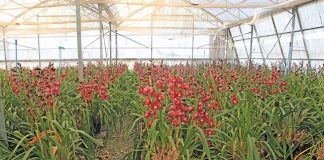
Photo: Supplied
What is biochar?
Biochar is produced during the pyrolysis of wood or farm waste, a process that applies heat without oxygen. Biochar is created at a much higher temperature than ordinary charcoal, making it more stable and porous, and allowing it to remain in the soil for hundreds of years. Ordinary charcoal decomposes within a couple of years, depending on climatic conditions.
Who came up with the idea of using it to enrich the soil?
It’s thought to have originated around 2 000 years ago in the Amazon basin, when people produced it by charring organic waste in primitive ovens with a low supply of oxygen.
This special charcoal was added to the soil, resulting in patches of rich soil that retained their fertility for centuries and later became known as terra preta (Portuguese for ‘black earth’). It’s said that a crop planted in terra preta can produce a yield up to four times greater than in any other soil, and local farmers who mine it claim that a given volume can double in size within 20 years if left undisturbed.
What is the chemical mechanism for its effectiveness?
Biochar is a negatively charged compound, and as such helps to improve the cation exchange capacity of the soil. This in turn increases the retention of soil nutrients and reduces run- off. The current hype surrounding it centres on its ability to draw carbon from the atmosphere and serve as a carbon sink in the soil.
Can farmers earn carbon credits for using biochar?
The potential is there, but the market must first be established. In addition, consensus
will need to be reached on the way in which carbon credits are calculated and rewarded.
We’re working with two groups that deal with carbon credits and there’s talk of earnings of up to €250/t [about R4 700/t], but until I see this realised I’m not getting too excited!
Senfore Soil Conditioning has developed its own biochar product called Restore. Tell us more about it.
My business partner, Luke Boshier, used biochar on his farm near Stanford, and also helped smallholder farmers in Uganda and Malawi to use it, with great results.
He combined biochar with chicken litter, as it’s nutrient-rich and contains bacteria from the poultry’s digestive system. In the soil, these bacteria help to break down organic matter and increase the soil’s water-holding capacity.
We’ve since pelletised this product to ease transportation and application.
Why did you commercialise this product?
Stanford is in an ecologically sensitive region, close to protected areas and wetlands. We wanted farmers here to use the product in order to reduce chemical run-off. But we were also keen to improve the sustainability of these farms by increasing soil fertility.
So we started a crowdfunding project, where community members would sponsor the use of the product on the farms. Unfortunately, this never took off, as we could only get 20 people to sign up as sponsors.
It was also difficult to convince farmers to use the product. Most weren’t interested, arguing that their current production practices had worked for their fathers, so they saw no reason to change. Those who used the product once, however, saw the results and embraced it enthusiastically.
How and when should the product be used?
We suggest you use it like any ordinary fertiliser. Apply it at a rate of 80g/m2 to 100g/m2 for vegetables, berries and melons, preferably before sowing or transplanting, and at 60g/m2 to 80g/ m2 for field crops. In orchards, use 2,5kg per fruit tree per year, once the trees are older than a year.
For the fastest results, you can apply Restore every six to eight weeks, but we have pasture-based dairy farmers who use it only once or twice a year with good results.
Although results will be evident after the first application, it takes between three and eight years, depending on application volumes, before the carbon content of the soil reaches optimal levels.
Can you give an example of how Restore has improved the soil?
A soil analysis by SGS revealed that the cation exchange capacity of a farmer who used our product increased from 1,64 to 38,1 within only five years. The pH of his soil increased from 5,8 to 7,2, while the carbon content increased from 0,48 to 5,36.
Restore also unlocked various soil nutrients. The phosphorus content increased from 8mg/kg to 1 443mg/kg, calcium increased from 275mg/kg to 4 900mg/kg, magnesium from 25mg/kg to 1 428 mg/ kg, and potassium from 0,36mg/kg to 474mg/kg.
This farmer has very sandy soil, but Restore decreased soil density from 1,5g/ cm3 to 0,63g/cm3. With Restore, he ended up using less fertiliser, improving soil health, increasing plant health and growth, and reducing compaction in his pastures.
So is this product only for use on sandy soils?
No, it assists in binding sandy soil, yet can also help to break compaction layers in heavier soil.
Where can farmers buy Restore?
We’re struggling to break into the market, as co-operatives tell us they have to remove something from their shelves if they include us. Cape Agri has agreed to allow farmers to buy Restore on credit, but it won’t hold any stock.
For these reasons, our products are currently stocked mainly by garden centres around the Western Cape. We’ve also secured a wholesaler in KwaZulu-Natal and are in discussion with one based in Gauteng.
Gardeners love the product, and while they’re also important as users, we’d prefer more farmers to apply it, as they have a greater impact on the environment.
What organic material do you use in your biochar?
Regenerative Space, a Stellenbosch-based non-profit organisation, runs an invasive
plant-removal programme on about 60 farms in the Overberg, Western Cape. The clearing of these alien trees, such as myrtle, hakia, Port Jackson willow and eucalyptus, has created various downstream jobs. We use the wood to make biochar, while other entrepreneurs use it to make firewood for export, wood pellets and charcoal.
Can farmers make their own biochar?
Yes, if they have plenty of alien trees and the time and capacity to do so. A pyrolysis machine costs in the region of R250 000, and we’re more than willing to advise them when they start out.
For technical information, phone Kobus Stoop on 066 129 6862, or email him at [email protected].
If you would like to become a distributor of Restore or are looking to adopt a more regenerative approach to farming by using Restore, phone Ben Hirshovitz on 076 749 9726, or email him at [email protected].











